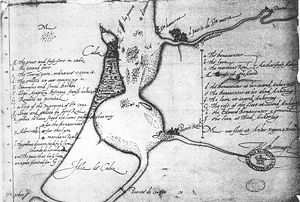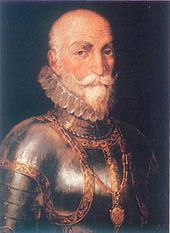- Singeing the King of Spain's Beard
-
Drake's 1587 Expedition Part of the Anglo–Spanish War 
Drake's map of his attack on Cádiz.Date 12 April – 6 July 1587[1] Location Bay of Cádiz, Algarve, Lisbon and the Azores Result English victory Belligerents  Spain
Spain
 Kingdom of England
Kingdom of EnglandCommanders and leaders Duke of Medina Sidonia (Cádiz)
Álvaro de Bazán (Lisbon)Francis Drake Casualties and losses 100 ships destroyed, captured or sunk[2] Unknown but many to disease Anglo-Spanish WarSan Juan de Ulúa – Goes – Haarlem – Ponta Delgada – Terceira Island – Zutphen – 1st Cádiz – 1st Calais – Gravelines – Ireland – Bergen-op-Zoom – Corunna – Lisbon – Berlengas – Strait of Gibraltar – Flores – Craon – Cape Finisterre – Blaye – San Mateo – Crozon – Cornwall – Las Palmas – 1st San Juan – Pinos – 2nd Calais – 2nd Cádiz – Turnhout – Groenlo – Azores Voyage – 2nd San Juan – Nieuwpoort – Kinsale – Ostend - CastlehavenDrake's 1587 expedition took place in the Bay of Cádiz, in April and May 1587. The English privateer, Francis Drake, led a military expedition against the Spanish naval forces assembling at Cádiz. Much of the Spanish fleet was destroyed, and substantial supplies were destroyed or captured. There followed a series of raiding parties against several forts along the Portuguese coast. A Spanish treasure ship, returning from the Indies, was also captured. The damage caused by the English delayed Spanish plans to invade England by more than a year. This incident, known to the Spanish as Drake's raid on Cádiz 1587, is known to the English by Drake's phrase “Singeing the beard of the King of Spain”.
Contents
Background
In the second half of the 16th century a series of economic, political and religious circumstances occurred that created tensions in the relations between England and Spain. Protestant England was brought into direct confrontation with Catholic Spain; Elizabeth I of England had been excommunicated by Pope Pius V in 1570 whilst in 1584 Philip II of Spain had signed the Treaty of Joinville with the French Catholic League, with the aim of eradicating Protestantism.
The constant raids by English privateers against Spanish territories in the Indies and against the Spanish treasure fleet, which carried the wealth which augmented the finances of Madrid, were considered by the Spanish as a threat to their economic interests. The support of the English for the United Provinces, who were at this time engaged in the Eighty Year's War against Spain, with the intention of gaining their independence, was sealed by the Treaty of Nonsuch in 1585, whereby it was agreed to form an Anglo-Dutch military alliance against Spain. The English support for the pretender to the Portuguese throne, Dom António, was another source of contention.
The increasing power of the Spanish Empire, which in 1580 had entered in a dynastic union with the Portuguese Empire under Philip of Spain, was expanding in the Americas and had the support of the German Habsburgs as well as the Italian princes, was regarded by the English as a major threat to their security.
In 1585 the tension existing between the two countries erupted into the Anglo-Spanish war of 1585-1604. Philip II ordered the arming of a great military fleet, which was to be come known as the Invincible Armada, and it was hastily assembled in the Spanish port of Cádiz and in the Portuguese port of Lisbon with the objective of invading England.
Drake's expedition
Preparations
Elizabeth I gave the English privateer, Sir Francis Drake, an outstanding leader of previous naval expeditions, the command of a fleet whose mission was to inspect the Spanish military preparations, intercept their supplies, attack the fleet and if possible the Spanish ports.[3] To that end, the Queen put at Drake's disposal four Royal Naval galleons: the Elizabeth Bonaventure, which was under Drake's own command; the Golden Lion, captained by William Burroughs; the Rainbow, under captain Bellingham; and the Dreadnought under Captain Thomas Fenner. A further twenty merchantmen and armed pinnaces joined forces with the expedition.[3][4] The cost of these boats was met by a group of London merchants, whose profits were to be calculated in the same proportions as their investment in the fleet; the Queen, as owner of the four Royal Naval vessels, was to receive 50% of the profits.[5] On the 12 April 1587[1] the English fleet set sail from Plymouth. Seven days after their departure, the Queen sent a counter-command to Drake with instructions not to commence hostilities against the Spanish Fleet or ports.[6] Drake never received this order as the boat carrying it was forced back into port by opposing winds, before it was able to reach him.[7]
Raid on Cadiz
Off the coast of Galicia the fleet was dispersed by a storm that lasted seven days, during which one of the pinnaces foundered.[8] After the fleet regrouped, they met two Dutch ships from Middelburg, Zeeland, who informed them that plans were in readiness to sail a huge Spanish war fleet from Cádiz to Lisbon[2]
At dusk on 29 April the English fleet entered the Bay of Cádiz. There were at that precise moment sixty carracks (naus) and various smaller boats in the port . Further sightings revealed twenty French ships present in the bay, and other smaller vessels were seeking refuge in Port Royal and Port Saint Mary, which were protected by sand banks that the larger carracks could not cross. Juan de Vega, Mayor of Cádiz, sent word to Alonso Pérez de Guzmán, who arrived from Sanlúcar that night to take over the defence of the main square. The Spanish galleons, who in the absence of the Governor of Castile were under the command of Pedro de Acuña, sailed out to meet the English fleet but were forced to retire back to Cádiz before the superiority of the English. Gun positions on the shore opened fire, shelling the English fleet from the coast with little effect, but they managed to repulse an attempted landing by launches at El Puntal.[9] During the night of the 29th and all the following day and night the battle raged in the bay. At dawn on the 1st May the English retreated having destroyed between 23[10] and 33[11] Spanish ships, with a combined weight of 10,000 tons.[2] Furthermore, they had captured four other ships, laden with provisions.[12]
Portugal
After leaving Cadiz, Drake's fleet set course along the south-west coast of Spain and Portugal, destroying all the shipping they encountered, including fishing vessels. On the 14 May, 1,000 men disembarked at Lagos in the Algarve and stormed the fortresses of Sagres, Baleeira, Beliche and Cape St. Vincent.[13] From there they sailed towards Lisbon where Álvaro de Bazán, 1st Marquis of Santa Cruz was supervising the preparations of the fleet that was to join the Cádiz fleet for the invasion of England. The English fleet stopped in Cascais, from where they proposed to Alvaro de Bazán an exchange of prisoners. Bazán responded that he was neither holding any English subject nor was he preparing for any action against England. Both Drake and Bazán refused to engage in combat merely an exchange of artillery fire between the English fleet and the Hispanic-Portuguese shore batteries, which produced no casualties.[8] Drake gave the order to weigh anchor and return to Sagres, where the English troops were supplied with water, whilst confronting the Spanish caravels that had pursued them from Cádiz. On 2 June the English sick and wounded were evacuated back to England. That same night a storm broke which prevented further sailing for three days.[8]
Second in command Captain William Burroughs considered the decision to land in the Algarve as dangerous and unnecessary. Drake's plans to sail to the Isle of Terceira, drove Burroughs to contradict Drake's orders, prompting Drake to relieve him of his command and place him under arrest.[14] Burroughs would be sent back to England, leaving Drake with only nine ships.[8]
The Azores
On 8th June, Drake's fleet sighted the Portuguese carrack, the São Filipe twenty leagues from the Island of San Miguel, returning from the Indies laden with treasure, and which after a brief exchange of fire was captured (it was the first ship to be captured on the return run from the Indies). After capturing the São Filipe and its enormous fortune of gold, spices and silk valued at £108,000[15] (of which 10% was to go to Drake[16]), the fleet returned to England, arriving on the 6th of July.
Conclusion
The expedition led by Francis Drake was a resounding military success: over 100 Spanish vessels of different tonnages were destroyed or captured during the expedition.[2] Economic and material losses caused to the Spanish fleet by the English attack ensured that Spanish plans for the invasion of England had to be postponed for over a year. It was not until August 1588 that the Armada was ready to leave for the British Isles.
Documents seized by the English with the São Filipe, which had details of the East Indies maritime traffic and the lucrative trade in the area, would years later be used as the basis for the founding of the East India Company.[17]
Explanation of Drake's phrase
The phrase, "to singe one's beard", was understood at the time to mean to inflict delay, though not crippling damage, upon an enemy. At the time, the best-known use of the phrase was by the Vizier of the Ottoman Empire. In 1571, an alliance of Christian nations led by Spain had destroyed the Ottoman fleet at the Battle of Lepanto. The Ottomans had rebuilt their fleet, and later captured the island of Cyprus from the Venetians, forcing them to sue for peace. The Vizier remarked to the Venetian envoys, "You come to see how we bear our misfortune. But I would have you know the difference between your loss and ours. In wresting Cyprus from you, we deprived you of an arm; in defeating our fleet, you have only shaved our beard. An arm when cut off cannot grow again; but a shorn beard will grow all the better for the razor."[18]
References
- ^ a b New Style, Gregorian Calendar. English sources often give dates from Julian cal. (old style)
- ^ a b c d Richard Hakluyt: A brief relation of the notable service performed by Sir Francis Drake, p.362 1587.
- ^ a b John Barrow: The life, voyages, and exploits of Admiral Sir Francis Drake.
- ^ John Lothrop Motley: History of the Netherlands reference to 24 ships and 4 Royal Naval ships.
- ^ Drake's agreement and relations with the London merchants, pag. 26-27.
- ^ Instructions to Drake 19 April; ibid, pag. 28.
- ^ English government's explanation for Drake's conduct; ibid, pag. 43.
- ^ a b c d Robert Leng, On board the English Fleet: Sir Francis Drake's memorable service done against the Spaniards in 1587.
- ^ Spanish reference given but inaccessible. To be researched further.
- ^ Despatch of the Duke de Medina-Sidonia to Philip II about the attack on Cádiz: Facsimil y transcripción.
- ^ Letter of Francis Drake to Francis Walsingham, secretary to Elizabeth I, (Barrow, p.102).
- ^ Letter[dead link] of Francis Drake to John Foxe British Library MS. Harley 167f. 104.
- ^ Amerilis.
- ^ Barrow, p.108
- ^ Inventory of the cargo of the San Felipe, p.50
- ^ Hans P. Kraus: Sir Francis Drake: A pictorial biography.
- ^ Christian Isobel Johnstone: Live and voyages of Drake, 1837.
- ^ Parker, Geoffrey (1995). The Times illustrated history of the world. Harper Collins. p. 156. ISBN 9780062700100.
Categories:- Anglo-Spanish War (1585–1604)
- Conflicts in 1587
- Naval battles of the Anglo-Spanish War (1585–1604)
- Privateering
- Royal Navy
- Spanish Navy
Wikimedia Foundation. 2010.


